All of the Rating Reviews and Recommendations Available Through Social Networking Are Unbiased
How to assemble, share, and implement client feedback that will skyrocket your concern growth by helping your customers succeed. Brian Halligan, CEO of HubSpot, was recently voted every bit a top CEO in America. He's helped grow HubSpot from $0 to a publicly-traded visitor valued at almost $6.5 billion with over 56,500 customers in more 100 countries. He's a best-selling author and was voted equally a top CEO among leaders such as Elon Musk and Marker Zuckerberg. What's the secret to his success?Brian explains it in six words: If we don't know what's correct, nosotros can't do more of it. If we don't know what'due south wrong, we can't do less of it. Without customer feedback, we are destined to neglect. If we don't know how our customers' experience, what makes them tick, or where they are frustrated … we will neglect.The earth's leading CEOs agree: Neb Gates Founder Microsoft Julia Hartz CEO Eventbrite Customer Feedback Strategy: The Only Guide You lot'll Ever Need
"Feedback is the breakfast of champions."

Your nearly unhappy customers are your greatest source of learning.

We see our customers every bit invited guest to a party, and nosotros are the hosts. It'south our task every twenty-four hours to make every of import aspect of the customer experience a picayune ameliorate.

Customer feedback is the ultimate truth. If you lot read customer feedback and listen to phone call center calls, you will actually get grounded.
Why Gather Customer Feedback?
The Customer Feedback Loop
Asking for Customer Feedback
Categorizing Customer Feedback
Acting On Customer Feedback
Following Up on Feedback
Why Gather Client Feedback?
What'south the benefit of gathering customer feedback?
Loyal customers grow a business faster than sales or marketing.
Still, if we never inquire for customer feedback, we'll never understand what drivesclient satisfaction. If we don't know what drives satisfied customers, it will be impossible to create customer loyalty.
Don't believe it? Here are the facts:
- Information technology costs 5x to 25x more money to learn a new client than keep existing ones happy.
- The #ane near mutual source of new leads are referrals.
- Highly-engaged customers buy 90% more often and spend 60% more per transaction.
Returning customers, or customer loyalty, is what grows a business. Not a 30-second, $300,000 commercial on NBC.
And it all starts with gathering customer feedback. Now, permit'south talk near how to practice that.
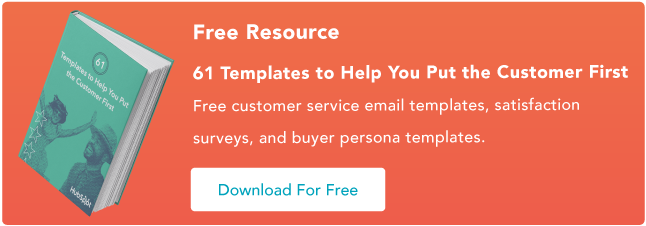
The A.C.A.F. Customer Feedback Loop
There's a strategic system for gathering and implementing customer feedback:The A.C.A.F. Customer Feedback Loop.
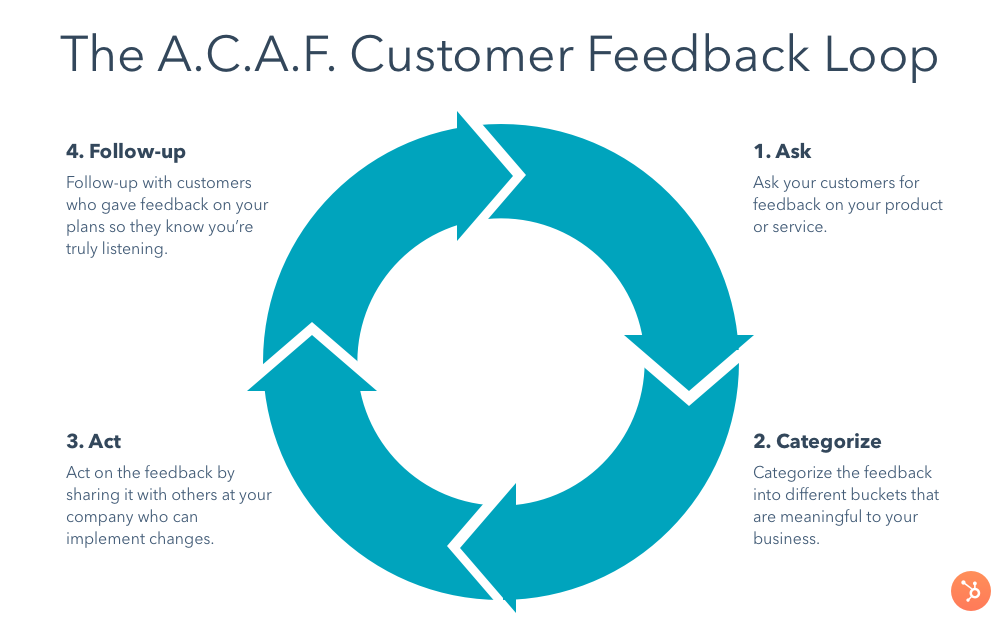
Here'southward how it works:
- Enquire for customer feedback
- Categorize the feedback
- Act on the feedback
- Follow-up with customers who shared feedback
Permit's dive into the specific steps.
Step One: Asking for Customer Feedback
What questions should we enquire? It depends on our goals.
- Do we need to understand overall trends in our client satisfaction over fourth dimension?
- Do we need to identify customer service issues that frustrate customers?
- Practise nosotros demand to uncover product issues to ameliorate our product?
In the following sections, we'll uncover all-time practices for all scenarios.
1. Questions to Empathise Overall Trends in Client Satisfaction Over Time
%20overall.png)
ane. Understanding overall trends in customer satisfaction over time
To identify overall trends in customer satisfaction, nosotros first accept to get a criterion on how happy (or unhappy) our customers are today. Then we can inquire the aforementioned question at ready intervals to sympathise how our customer satisfaction changesover time. This will help us place trends and solve new client issues.
The near pop ways to measure out overall customer satisfaction trends are:
- Net Promoter Score (NPS)
- Customer Satisfaction Score (CSAT)
- Social media monitoring
Permit'south suspension down the pros and cons of each option.
a) Net Promoter Score (NPS)
Net Promoter Score (NPS) is growing in popularity for measuring the likelihood a person will recommend your production or service. Information technology's one question with a scale of 1 to 10:

Not gathering feedback today? Learn more about HubSpot Service Hub's customer feedback tool.
NPS is calculated past subtracting the percent of detractors (customers who would non recommend you) from the percentage of promoters (customers who would recommend yous). It's commonly used as a tactic for measuring customer loyalty. In fact, customers who autumn into the "promoter" category tend to have an average customer lifetime value (LTV) that is 3x to 8x higher than those in the "detractor" category.
In addition, according to data from Bain and Visitor, companies with the highest NPS in their industry tend to outgrow their competitors past at least 2x.
Here are the pros and cons of using NPS:
| Pros | Cons |
|
|
b) Customer Satisfaction Score (CSAT)
Customer Satisfaction Score (CSAT) is a measurement of how satisfied a customer is with a specific interaction with a company. The question looks like this:
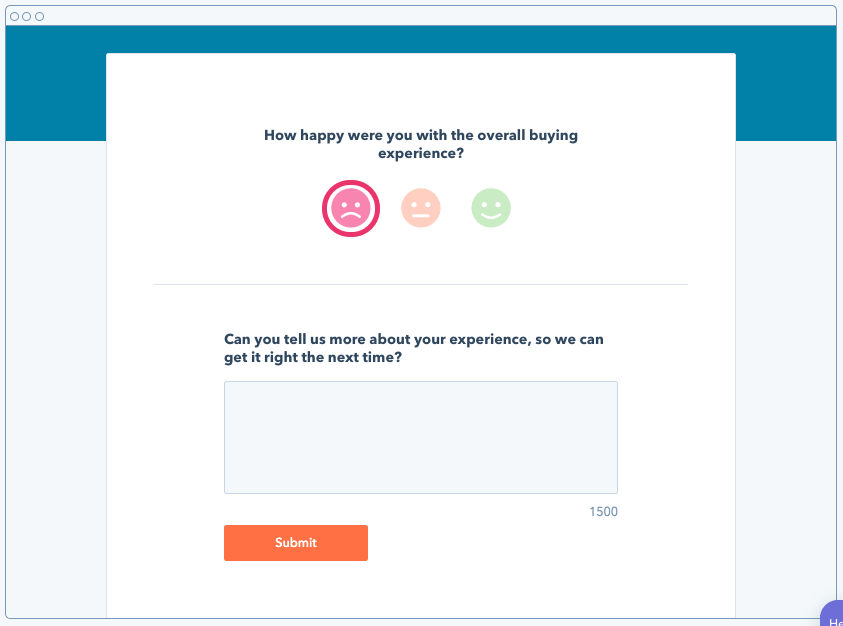
Not gathering feedback today? Try HubSpot's complimentary customer feedback tool.
CSAT questions are often asked at the cease of alive chats or knowledge base articles to get an thought of how helpful the solution was for the customer. We've wrote extensively nearly the strategy for building a knowledge base, so we're just skimming the surface hither regarding measuring the performance.
Here are the pros and cons for using CSAT:
| Pros | Cons |
|
|
c) Social media monitoring
Outside of gathering NPS and CSAT surveys, you tin can also listen to what your customers are really thinking about you past using tools like Google Alerts or Mention. They help yous identify social and forum mentions of your brand on websites like Facebook, Twitter, Quora, Yelp, TripAdvisor, and other tertiary-party review sites.
Nosotros asked Joei Chan, Content Marketing Manager at Mention, for her take on why social media monitoring is so valuable:
"People are talking about yous and your competitors constantly. They could exist request for assistance, lament about a bug, or raving about how much they beloved yous. And yous want to stay on top of all those conversations. Your customers' opinions matter, not just to PR & marketing, but to every squad — from customer support to product development to sales.
But sifting through irrelevant posts on multiple channels is overwhelming and can be a huge time drain. Sometimes it's not even possible when they don't tag or link to you. That'south where monitoring comes in. Monitoring tools make it piece of cake for yous to find people talking about you, but not necessarily to you (when they don't @mention your business relationship) — and attain out or take notes when necessary.
At that place are so many business opportunities to uncover if you know where to look."
Although there isn't a specific survey question yous tin inquire, it's important to go a general pulse on what your customers are maxim over time about your visitor.
Here are the pros and cons of social media monitoring:
| Pros | Cons |
|
|
[VOTE] How exercise y'all monitor trends in customer satisfaction over time?
What'southward the best way to measure trends in customer satisfaction over time? Vote to see the results from others:
At HubSpot, we use NPS as our primary metric to mensurate client satisfaction over time.
Nonetheless, at that place are plenty of great arguments against NPS as well. It's entirely upward to weighing the pros and cons of each potential surveying method and figuring out which method works all-time for yous. Regardless of the question we choose, it'southward important to ask the same question at prepare intervals over time. At HubSpot, we choose to ask our NPS question monthly to proceed a pulse on our customer happiness over time.
Asking on a the aforementioned question (i.e. NPS) on a consistent footing has two cadre benefits:
- It identifies specific hurting-points in the customer journey.
- Information technology identifies common patterns in happy/unhappy customers.
First, request the same question helps us spot pains during the customer journey. For example, let's say after asking the same question nosotros see these results:

The next question to ask is, "Why did customer satisfaction drop during onboarding?"
Even so, if we didn't consistently our customers via customer feedback surveys, we would NEVER realize that satisfaction dropped specifically during onboarding.
2d, asking the same question helps us place mutual patterns in happy (or unhappy) customers. For example, let'south look at this faux NPS data:

Permit's say this company wanted to sympathize demographic patterns of the 3,643 NPS respondents who rated them a nine or 10 (a.k.a. their NPS Promoters).
They analyze their data and find that 90% of their promoters were SaaS companies with 200+ employees. At present they use this data to inform their marketing & sales strategy, doubling downwardly on companies that fit this demographic, and starting time seeing a 20% lift in close rates and a 54% lift in retentiveness.
WABOOM!
If they didn't consistently ask for customer feedback they would non take uncovered these patterns.
Side by side, let's narrow our customer feedback to place trends from our customer service squad.
2. Questions to Identify Customer Service Bug That are Most Frustrating for Customers
%20service.png)
The next set up of questions are for the customer support and/or customer success leader. They are focused on analyzing how their team is performing.
The most mutual questions, "How is my team doing at servicing our customers? Are our customers happy? Are we delivering fast, loftier quality service?"
For example, after a support rep answers a question, is the customer satisfied? Here are the most common types of questions to ask to find out:
- Net Promoter Score (NPS)
- Customer Satisfaction Score (CSAT)
- Customer Attempt Score (CES)
Let's break downwards the pros and cons of each pick.
a) Net Promoter Score (NPS)
Every bit a reminder, Net Promoter Score (NPS) measures the likelihood a person will recommend your product or service.

Not gathering feedback today? Try HubSpot's free customer feedback tool.
However, does this help us clarify the effectiveness of our support team? Is it an accurate measurement tool compared to other options out there?
Potentially. Here are the pros and cons:
| Pros | Cons |
|
|
b) Customer Satisfaction Score (CSAT)
As a refresher, the Customer Satisfaction Score (CSAT) question measures how satisfied a customer is after a specific interaction with a company.
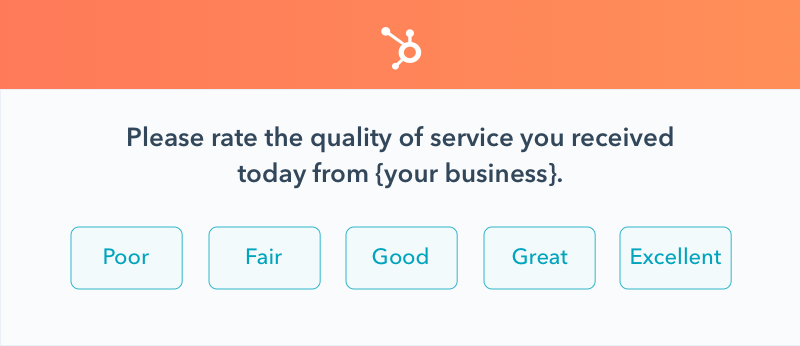
Not gathering feedback today? Endeavour HubSpot's complimentary customer feedback tool.
CSAT questions are ofttimes asked at the end of live chats or knowledge base articles to get an idea of how helpful the solution was for the customer.
This question shows how happy your customers were with the whole back up interaction -- from finding your contact information, how long information technology took for yous to reply, the chat they had with your team, and other follow-up conversations.
Here are the pros and cons:
| Pros | Cons |
|
|
c) Customer Effort Score (CES)
Customer Try Score (CES) helps you measure how much effort was required by your customers to become their problem solved. Here'due south the question:
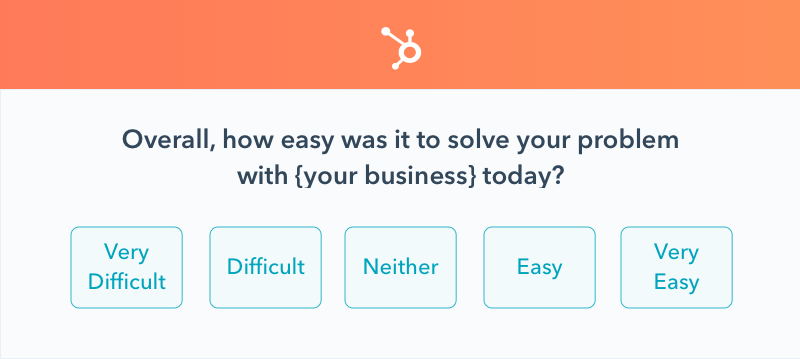
Not gathering feedback today? Attempt HubSpot's complimentary customer feedback tool.
Measuring the difficulty of a problem resolution versus a customer'southward satisfaction after the resolution is a slightly unlike modification to the standard CSAT question we discussed in the previous section. And different the NPS question, which emphasizes gaining "promoters" to recommend your business to others, the CES focuses on creating an "effortless experience" for customers.
In that location's a fascinating Harvard Business organisation Review article that dives into CES in more detail. In summary, making an experience depression attempt is one of the all-time ways to increase customer loyalty.
Finally, according to CEB, 96% of customers with a high CES scores showed reduced loyalty in the time to come, while that was the case with only ix% of those who reported low CES scores.
Here are the pros and cons:
| Pros | Cons |
|
|
[VOTE] How do YOU identify customer service issues that are nearly frustrating for customers?
What's the best way to identify customer service issues that are most frustrating for customers? Vote to see the results from others:
Whether you choose NPS, CSAT, or NPS, the cardinal is asking for customer feedback after a support ticket and/or a live chat is closed.
This helps amend the response charge per unit and reduce bias that could modify the response if the customer feedback survey is sent later.
Aside from improving the customer feel, it besides gives Client Success leaders insight into what team members are the highest performing. Yous tin and so contrary engineer qualities of top-performing CSMs to improve preparation and hire other top-performers.
iii. Questions to Uncover Production Issues to Improve Your Product
%20product.png)
The last set of questions are typically for the founders, executive teams, and/or production team leaders.
The most common questions include, "How is my product doing at delivering value to our customers? Are they able to achieve their goals with our product? How do they like X new feature? Are there whatsoever central features missing?"
Success teams and their product counterparts also want to utilize feedback mechanisms to identify opportunities for improvement in their product. They tin do this in a few means:
- NPS
- In-app surveys
- Suggestion board
Let'southward break down the pros and cons of each option.
a) Internet Promoter Score (NPS)
As a reminder, Internet Promoter Score (NPS) measures the likelihood a person will recommend your product or service.

Not gathering feedback today? Attempt HubSpot's free customer feedback tool.
However, does this aid us clarify production issues our customers are experiencing?
Potentially. Let'due south await at the pros and cons:
| Pros | Cons |
|
|
The biggest issue with NPS, nonetheless, is that it doesn't dive deep plenty into specific product issues. That's where in-app product surveys can be helpful.
b) In-App Surveys
If you lot sell a software product, request for feedback directly inside the app is a fantastic method for collecting product feedback.
Information technology helps you narrow in on specific bug your customers are experiencing. Still, it can also feel like
- "What is {insert product characteristic} helping you accomplish?"
- "What issues, if any, are you having with {insert product feature}?"
- "What features do y'all recollect nosotros're missing today for {insert production}?"
Regardless of what questions yous inquire, in-app surveys often assistance support other commons surveys like NPS. For example, Steve Palmer , Customer Success & Growth at Knack, likes to combine a quantitative score from something like NPS with qualitative feedback, too:
"NPS is important simply we're interested in more than only a quantitative score. For these reasons, we prefer the Net Promoter Score combined with custom survey questions."
There are hundreds of in-app questions you can ask. Here are the pros and
| Pros | Cons |
|
|
c) Characteristic Request Board
A massive part of build a product is identifying new features customers desire. The easiest way to figure it out? Inquire them!
Creating a "feature request board" is a mutual tool for gauging product feedback from existing customers. For example, here'southward the customer feedback board we utilize at HubSpot to help build our product.

We've likewise seen other companies use Trello as a tool to publicly share their product roadmap. It'south an incredible mode to crowdsource feature requests.
Here's a dandy example from Loom — the Google Chrome extension for recording videos in seconds — who

According to Joe Thomas, a
"In that location are two major reasons for publicly sharing what nosotros plan to build for the people using Loom. Kickoff, it builds confidence with the people and companies using our software most what will be available and when. Second, it elicits more feedback from people using our software because they come across what you're building which ways they can hold or contest what is coming next."
Here are a few pros and cons:
| Pros | Cons |
|
|
[VOTE] How do YOU gather customer feedback to improve your product?
What's the best way to gather customer feedback that improves your product? Vote to see the results from others:
We actually use a mixture of all three of these methods at HubSpot. But we're always looking for new and interesting ways to assemble customer feedback.
The side by side step in the A.C.A.F. Customer Feedback Loop is categorizing the feedback.
Stride Two: Categorizing Customer Feedback
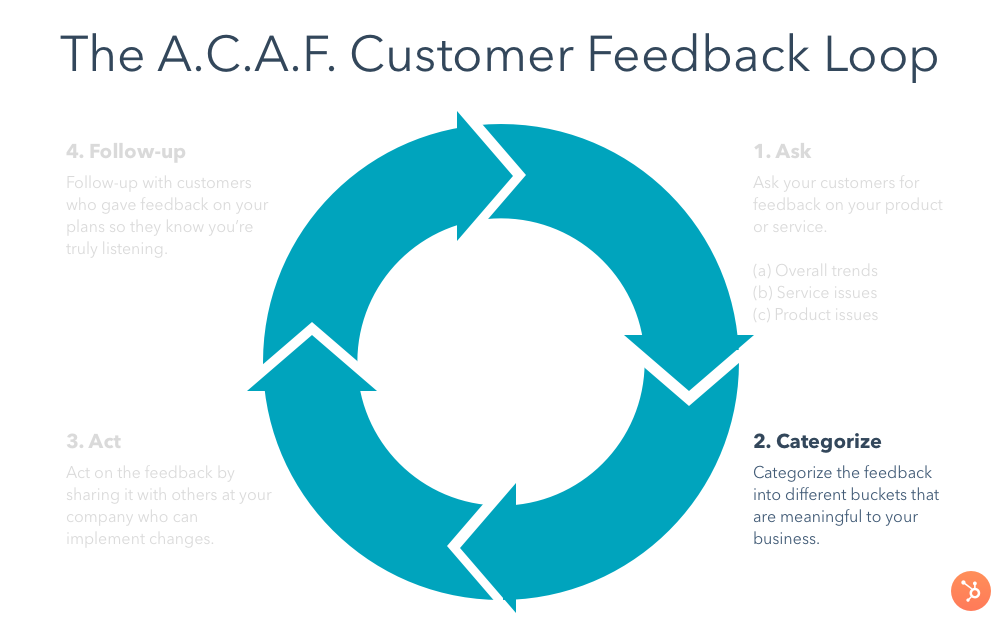
Congrats! Now yous've learned how to inquire for customer feedback. The next footstep is finding a scalable arrangement for categorizing the feedback.
If you don't organize your feedback, information technology'll probably turn into an incessantly scrolling spreadsheet. Yikes, this hurts my brain just thinking most it.

How do you organize your client feedback? In that location are a typically three main categories you can saucepan customer feedback into:
- Production feedback
- Customer service feedback
- Marketing & sales feedback
You can also break downwards each macro category into different subcategories which nosotros'll cover beneath. It's quickly worth noting you'll save time by using client feedback software to assist with organizing your feedback — versus compiling information into spreadsheets and running time-consuming PivotTables and VLookups to dissect trends.
Co-ordinate to Scott Tran, founder ofSupport Driven, it'due south vital to factor in both positive and negative feedback (regardless of category).
"How can you make good decisions for the customer without listening to customers? You demand to listen to the good, the bad, and the ugly feedback to make expert decisions."
1. Product Feedback
After you inquire for production feedback (the first footstep in the A.C.A.F. Customer Feedback Loop), you'll become a massive spreadsheet of information.
However, you'll desire to bucket that into different subcategories. Here are a few of the well-nigh common ones:
- Major product bugs.These are extremely urgent problems that foreclose users from getting the core value out of your production. For example, if y'all have an instant messaging production and users cannot send a message.
- Minor product bugs. These are minor problems that don't distract from the core product value. For example, using the same hypothetical messaging product, this would be if your users couldn't insert a specific emoji into their message.
- Feature requests. We covered feature requests extensively in the previous section of the A.C.A.F. Customer Feedback Loop framework. The next step is prioritizing feedback based on a mixture of book of requests, potential touch of building that feature, and opportunity costs associated with each option. Here'southward an keen guide from Trello on how to manage feature requests.
You can manually categorize this feedback using a spreadsheet, assigning labels to specific columns, then creating a PivotTable or Five-Lookup … simply this tin can be time-consuming.
An easier way is leveraging a customer feedback tool that helps you categorize the feedback past assigning smart tags and bucketing everything into categories automatically. HubSpot offers customer feedback tool to help with exactly this.
2. Customer Service Feedback
The next primary category is getting feedback about your customer service. The three nigh common places to enquire for feedback is:
- Live conversation
- Knowledge base of operations articles
- Electronic mail follow-up (after support case is closed)
When y'all stop a live conversation y'all'll often encounter a survey:
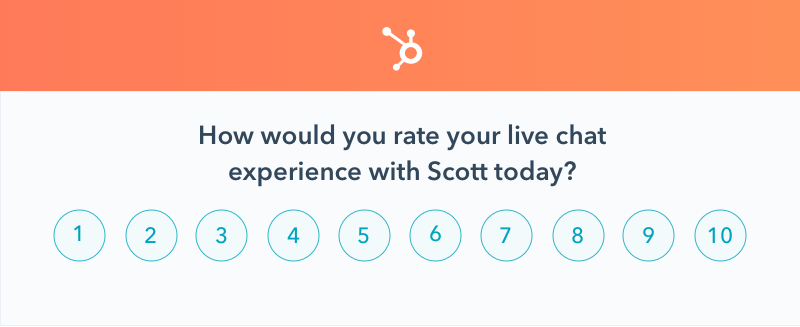
Or at the bottom of a knowledge base commodity when you're done reading:

Or after yous closed a support ticket and you go sent a follow-upward e-mail:

Regardless of how the feedback survey is sent, all the data volition become aggregated into a central identify to analyze your customer feedback.
This makes information technology piece of cake to place patterns in your reporting to find answers to these common questions:
- "What are the nigh commonly asked questions?"
- "What knowledge base articles don't give users the answers they're looking for?"
- "What is our average response time in live chat?"
- "During what phase in the customer journey do people get stuck?"
Building a sustainable system for analyzing customer service is vital for our business growth. If nosotros don't know where people are frustrated, we tin't amend our customer service.
If we tin't improve our service, our customers volition leave for some other company who will.
3. Marketing & Sales Feedback
The final category of organizing customer feedback is focused on your marketing and sales.
Let's say one of your sales reps mistakenly promised a feature that wasn't gear up for the next vi months. Subsequently a client signs a contract, or submits their beginning monthly payment, that will likely arm-twist this customer response:

Your client success team is at present destined to become practice on dealing with angry customers. They were promised something past sales that didn't deliver.
The same can happen with marketing. For example, pretend your marketing squad mistakenly writes that your production is compatible with Microsoft Outlook on the website. A customer purchases your product, because it's supposedly compatible with Microsoft Outlook, which they later learn is not true. That volition cause massive headaches for your Support squad later on downward the road.
If you have a tight customer feedback loop for your marketing and sales teams, these headaches will exist entirely avoided.
Some other strategy for categorizing customer feedback comes from Justin Wilcox of Customer Evolution Labs. He suggests using Postal service It Notes to visually categorize different buckets of feedback.
"The first thing I do is go through my notes and assuming the salient points. Then I write upwardly an (online) Post It annotation for each of the nuggets in i of my interviews. As I create the Mail Its, I grouping mutual themes together. In one case I'm finished creating the Post Its, I ordinarily accept quite a mess. To clean that upwards, I get rid of any Post It that was merely mentioned by i customer and go on everything that was mentioned twice or more.
Side by side, I prioritize the groups of Post Its based on how many customers mentioned those concepts. Finally, I create a summary with the cadre concepts and screen shots of the Post Its. Now I have an piece of cake to read written report of the findings, in order of importance, complete with real customer quotes!"
Step Three: Acting On Client Feedback
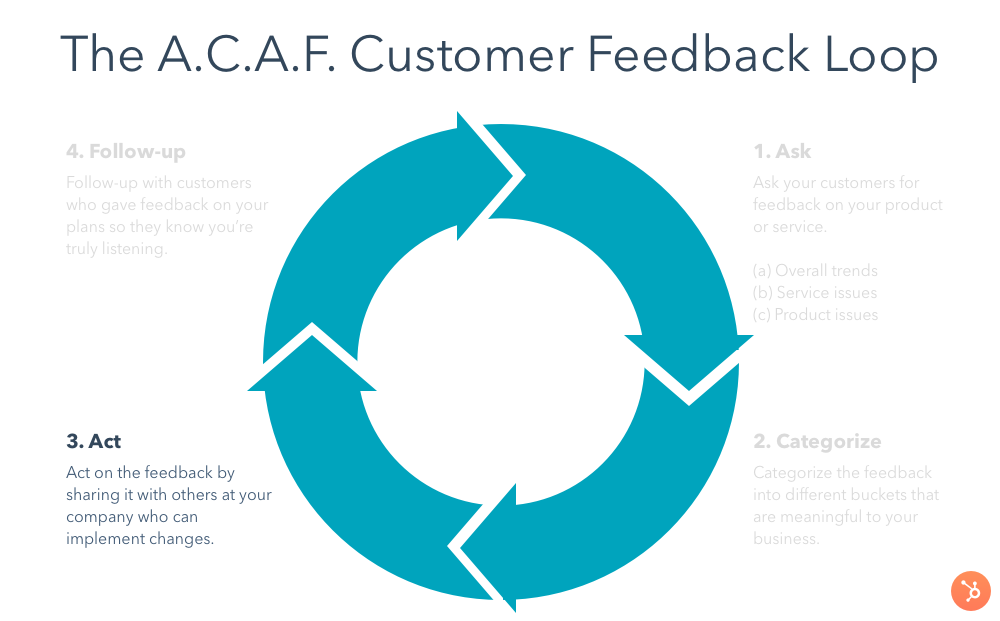
At present that you've categorized your customer feedback, information technology's fourth dimension to act on information technology. The first footstep is sharing the feedback with these 3 teams:
- Production team
- Customer Support team
- Marketing and Sales team(s)
You can either share feedback in real fourth dimension past using electronic mail alerts or Slack alerts.

Or y'all can share the customer feedback at set up intervals such as daily, weekly, or monthly digests.
Regardless of when you share the feedback, it's vital that yous do share the feedback. We've institute that too many times companies ask for feedback merely don't do anything with it.
Why ask for customer feedback if it's simply going to sit down idle in a spreadsheet?
Nosotros asked Ellie Wilkinson , Sr. Managing director of Customer Success at Moz , how she implements customer feedback from surveys:
"Customer satisfaction survey data is an invaluable source of new ideas to exam equally well as a great gauge at how to prioritize improvements. Having this kind of data helps us get into the mind of our customers, brand a case to effort something new, and even approximate the impact that an improvement volition accept on user experience."
The key is sharing information technology with the right teams at intervals (real time, daily, weekly, monthly) they prefer ... regardless of whether it'south a new product idea or making improvements on existing products.
Some other consideration is who are the people filling out these surveys in the first identify. Yes, we should e'er share client feedback with the right teams, but sometimes the decision-maker isn't who ends up being surveyed.We askedMatt Hogan, Caput of Client Success at Intricately, to counterbalance in on this topic:
"The #1 error is understanding who controls the power on your customer's end. The end users could exist giving you lot 10's, merely the decision-maker doesn't get surveyed and isn't seeing the ROI. The decision-maker ultimately makes decisions based on quantitative results and not the stop-users feedback.The best mode to handle this is to maintain the perspective that this could be happening, and employ the cease-user's feedback equally leverage for getting on the phone with the decision-maker."
It'south of import to know who is making decisions on the customer's side. All likewise oft, nosotros survey people who don't concord determination-making power, which gives united states a skewed view of our data and what we can practise about it
The final stride is then following-upwards with customers that accept provided feedback.That'due south where about companies fall brusque.
Step Four: Following Upwards on Feedback

Regardless of what type of feedback nosotros share with a company, we simply desire ii things:
- That information technology's easy for u.s. to requite feedback
- That nosotros feel like our voice is existence heard
The beginning can be solved with customer feedback software. The second is a petty tougher.
What's the core problem? People don't share feedback with companies because they feel similar they're talking to a wall. According inquiry from a UK customer experience group, they found that 43% of customers don't leave feedback considering they don't think the business organization cares.
THAT IS CRAZY!
If we don't make our customers feel appreciated for their feedback, both positive and negative, they simply won't give feedback. If we don't become customer feedback we risk our business failing.
When asked Curtis Morris , CEO at Qualaroo, he agreed it's vital to follow upward with survey respondents:
"Closing the loop with customers that consummate your satisfaction survey is both the most important and most ignored step in a proficient client satisfaction campaign. Ensuring that your team tin acknowledge and thank anyone that completed the survey (close the loop) is disquisitional to ensuring that customers will continue to provide you feedback."
If we don't routinely follow-up with customers, we risk losing trust with them. We asked Nils Vinje , VP of Customer Success at Rainforest QA, to elaborate on this topic:
" Whether you utilise NPS or a full general client satisfaction survey, the virtually common error I see people make is doing a lot of work to put the organisation in place without doing the work to go teams/the company ready to human activity on the feedback that is collected. If a customer tells you the exact aforementioned feedback twice, meaning you didn't address the event after they raised it in the starting time survey, y'all will lose brownie and they may not be willing to keep filling out your surveys in the future.
You tin't act and deliver on every piece of feedback that comes through but you can address every slice of feedback that comes through in some way. Providing a response, fifty-fifty if what the customer is requesting is non something you will do, is always improve than no response at all or 'it'due south on the roadmap.' Be very clear and you will build trust."
But what makes our customers feel similar their being heard?
Beginning, they desire a prompt response fourth dimension. In fact, 81% of customers say they would be willing to leave feedback if they knew they would get a fast response. We can improve this by:
- Publishing a report with our customer feedback so far and how nosotros've implemented it
- Using a public feature asking Trello lath (similar this example from Loom)
- Mailing give thanks you messages to people who gave you incredible feedback
- Personalizing an email response (beyond a canned template) genuinely thanking them for taking time out of their busy schedules to give feedback
When we feel similar our voice is being heard — and that something will be washed about it — we aren't agape to share our opinions.
Information technology's our responsibility as a business to follow upwardly with customers who share feedback. If we don't, they won't share feedback later on on, and we run a college run a risk of business concern failure because we're non capturing the good and bad feedback from our customers.
Additionally, if you lot have thoughts on gathering customer feedback, we'd love to hear from you. Send united states of america aTweet over at @HubSpot about how y'all gather customer feedback.Good luck!
Start Turning Customers Into Promoters
Apply HubSpot's customer service software to connect with customers, and grow through their success.

Created Past
-

Scott Tousley
Growth Marketing Team Lead @ HubSpot
Source: https://www.hubspot.com/customer-feedback
0 Response to "All of the Rating Reviews and Recommendations Available Through Social Networking Are Unbiased"
Post a Comment